|
Red-breasted Nuthatch / Sittelle à poitrine rousse (Sitta canadensis) |
 |
Introductory notes:
While sexes are easily separated by the colour of the crown, age can be difficult to determine. Unlike most North American passerines, HY/SY Red-breasted Nuthatches have no distinct molt limits on the wings, and tail shape/condition does not vary by age. Overall appearance of the wing can be used to assess age, but with caution, especially when very fresh or worn. |
QUICK TIPS:
| 1) Look
at the crown - it is black on males, but a duller dark gray on females
2) Check the lesser coverts - on HY/SY birds there may be a contrast between bluish lesser coverts and a more brownish wing, while on AHY/ASY birds all lesser, median, and greater coverts should have a uniform bluish-gray appearance
3) Consider the overall quality of the wing - HY/SY birds have juvenile feathers that tend to be grayish-brown with minimal bluish edging anywhere, while AHY/SY birds have a more uniformly gray wing with bluish edging to at least the greater coverts, and usually also to some extent on the primary coverts and secondaries |
Species account updated January 2011 |
Ageing and sexing overview:
Ageing and sexing details:
|
JAN - JUL: after-second-year
male |
Males of any age can be readily recognized by the solid black cap, but age is not as easy to determine at a glance, and usually requires close examination of the open wing.
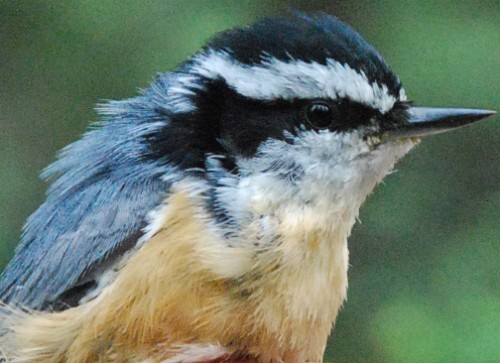
The distinctly black cap and relatively dark orange underparts identify this as a typical
male Red-breasted Nuthatch, but age cannot be determined from this view. Note that
although the plumage appears somewhat ruffled and worn, that is common by June
for nuthatches of all ages.
Photo by Manon Dubé, Banff
National Park (AB), June 2007
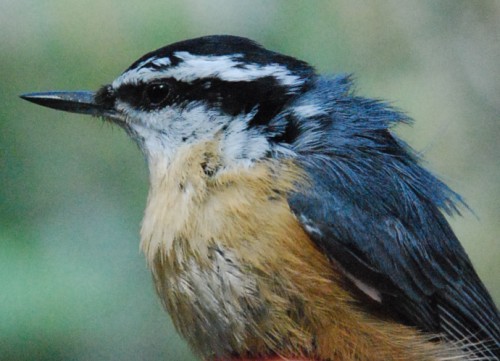
Another somewhat ruffled June AHY male, showing that sometimes the breast is not
uniformly orange, nor even particularly dark.
Photo by Manon Dubé, Banff
National Park (AB), June 2007
AHY males have a uniformly bluish-gray wing.
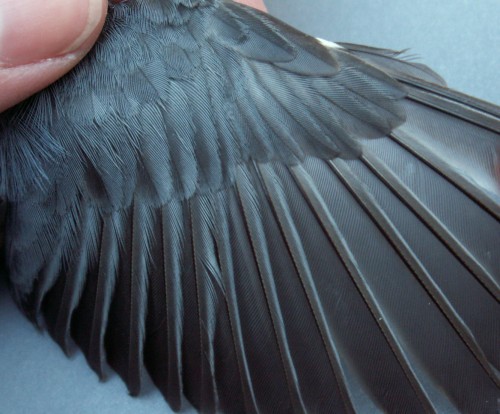
A typical AHY male wing, uniformly bluish-gray and lacking any molt limits.
Photo by Manon Dubé, Banff
National Park (AB), June 2007
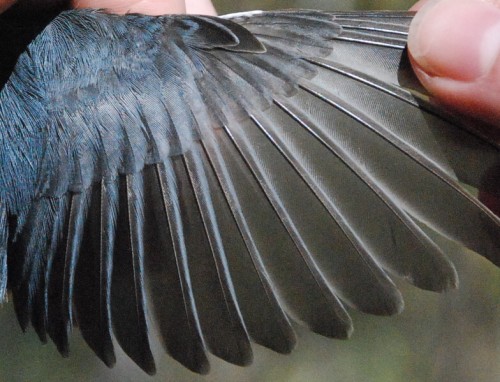
A view in bright sunlight, showing a bit of a difference between the more bluish greater coverts
and the rest of the wing, but notice that there is still no trace of brown, and there is also
distinct blue edging on the secondaries that SY nuthatches would not have.
Photo by Manon Dubé, Banff
National Park (AB), June 2007
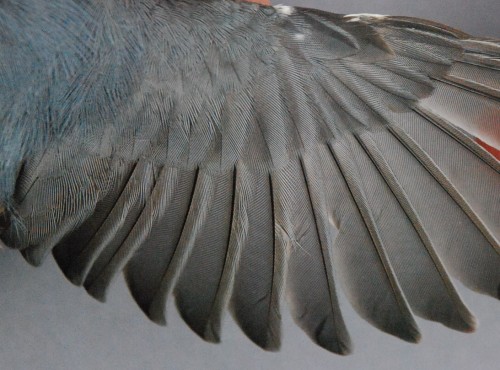
A somewhat paler wing, closer to what might be expected on a female, hence sex is better
determined by the colour of the crown. However, the wing is still valuable for determining
age, and in this case the uniformity of the wing, combined with the broad and gray-edged
primary coverts is indicative of ASY rather than SY.
Photo by Manon Dubé, Banff
National Park (AB), June 2007
Shape, colour, and condition of rectrices differs relatively little by age and sex in Red-breasted Nuthatches, and therefore the tail is generally not useful for identification.
RETURN TO AGE/SEX
OVERVIEW
|
JAN - JUL: after-second-year
female |
Females of any age can be distinguished from males by their paler slate-coloured crown, but as with males, age is best assessed by looking at the open wing.
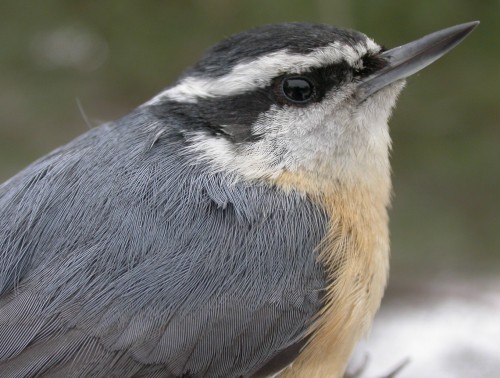
A typical female Red-breasted Nuthatch, with a dull cap and relatively pale orange below.
Photo by Marcel Gahbauer,
McGill Bird Observatory (QC), January 2006
The wing of ASY females is typically somewhat paler and duller than that of ASY males, but similar in that it lacks any molt limits.
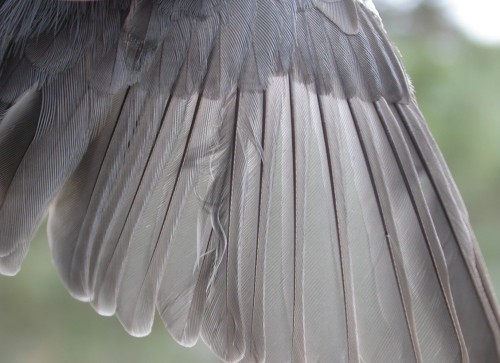
Note that although this wing is relatively dull in appearance, it is uniform, and the primary
coverts are broad with a fair amount of bluish edging.
Photo by Marcel Gahbauer,
McGill Bird Observatory (QC), January 2006
Shape, colour, and condition of rectrices differs relatively little by age and sex in Red-breasted Nuthatches, and therefore the tail is generally not useful for identification.
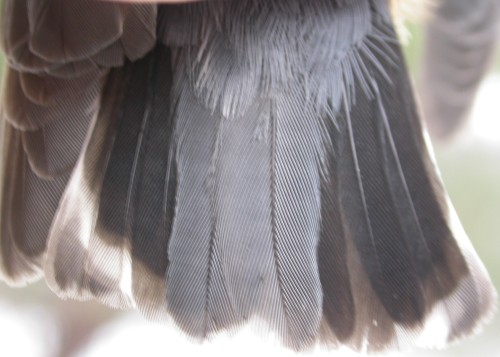
A typical ASY female tail.
Photo by Marcel Gahbauer,
McGill Bird Observatory (QC), January 2006
RETURN TO AGE/SEX
OVERVIEW
|
JAN - JUL: second-year
male |
SY male Red-breasted Nuthatches generally look the same as older males, with the wing usually providing the only means of distinguishing age.
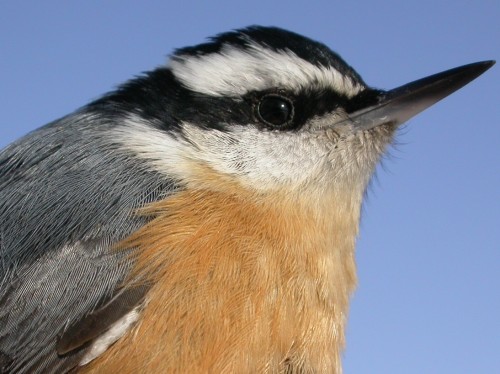
An example of a SY male with a particularly dark orange breast.
Photo by Marcel Gahbauer,
McGill Bird Observatory (QC), January 2006
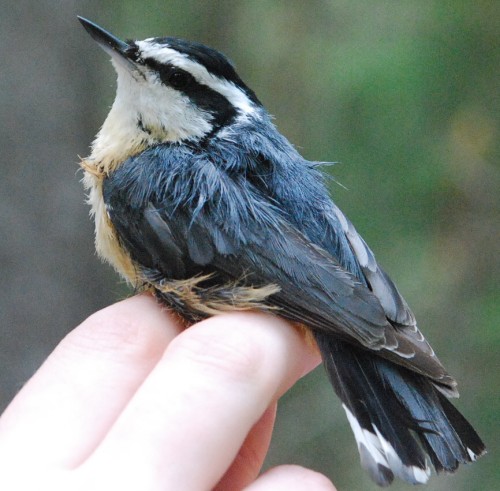
A much paler and more worn SY male later in the year, with a distinct contrast evident
between the blue back and the faded brown juvenile primaries (but beware that even
ASY nuthatches can be fairly worn and faded by mid-summer).
Photo by Manon Dubé, Banff
National Park (AB), June 2007
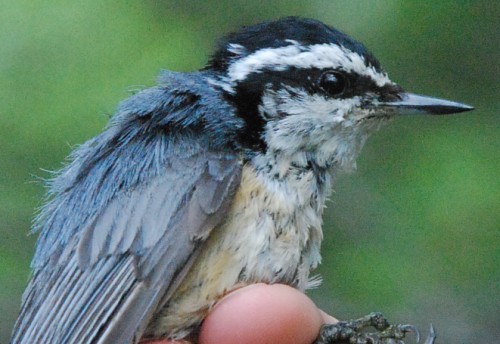
Another very pale and worn-looking SY male, with colour of the wing somewhat
less obvious than in the previous example.
Photo by Manon Dubé, Banff
National Park (AB), June 2007
SY males can best be aged by the wing, but since the preformative molt is often very limited (i.e. commonly only lesser coverts replaced), molt limits are typically not obvious, and judging the condition of the wing can be difficult, especially in late spring and early summer.
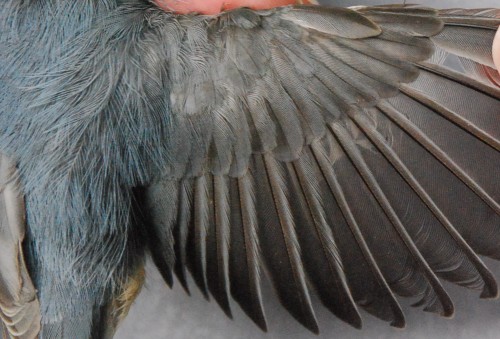
Although no distinct molt limits can be identified, this appears to be a SY wing on the
basis of a generally brownish appearance with little or no blue edging on most feathers.
Photo by Manon Dubé, Banff
National Park (AB), June 2007
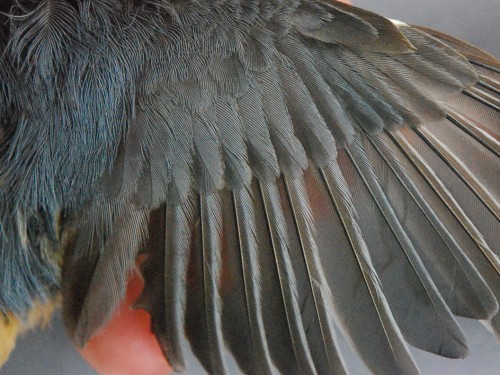
This individual has begun its prebasic molt, with the first two primaries and corresponding
primary coverts already replaced; the contrast between them and the generally brownish
retained adjacent primaries suggests that those are likely juvenile feathers.
Photo by Manon Dubé, Banff
National Park (AB), June 2007
As noted previously, the appearance of the tail is similar across all ages and sexes for Red-breasted Nuthatch.
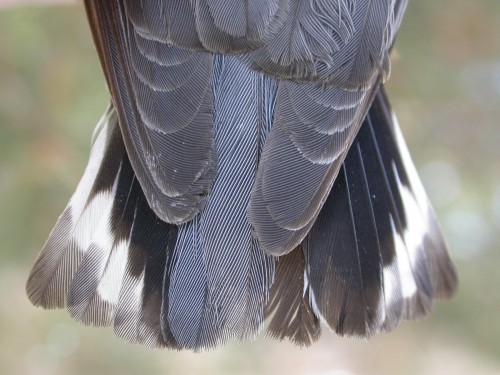
Photo by Marcel Gahbauer,
McGill Bird Observatory (QC), January 2006
RETURN TO AGE/SEX
OVERVIEW
|
JAN - JUL: second-year
female |
SY females, like males, are best aged by looking at the open wing.
The wing of SY females is generally brownish, lacking any bluish edging. Note that ASY females also do not have much colour, and therefore ageing should be done with care, and some intermediates are best left as AHY.
As with other age/sex categories, the tail provides no reliable clues.
RETURN TO AGE/SEX
OVERVIEW
|
JUN - DEC: after-hatch-year
male |
Males have solid black caps and moderate to dark orange underparts. Age is most reliably determined by skull pneumatization, but in most cases the open wing provides useful clues too.
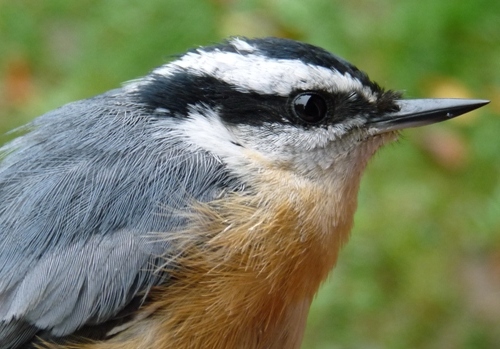
A typical AHY male, with a solid black cap and moderately dark orange underparts.
Photo by Marcel Gahbauer,
McGill Bird Observatory (QC), October 2010
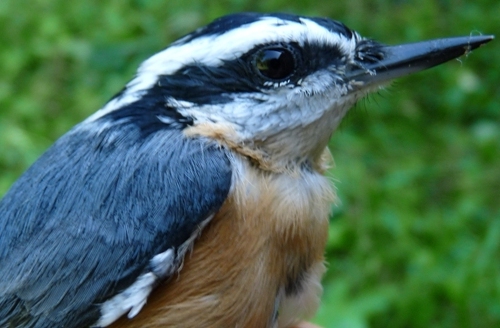
Another example, slightly paler on the throat, but otherwise similar.
Photo by Marcel Gahbauer,
McGill Bird Observatory (QC), August 2009
AHY males usually have distinctly bluish wings, most notable in borad edging on the greater coverts and narrower edging on the primary coverts and secondaries.
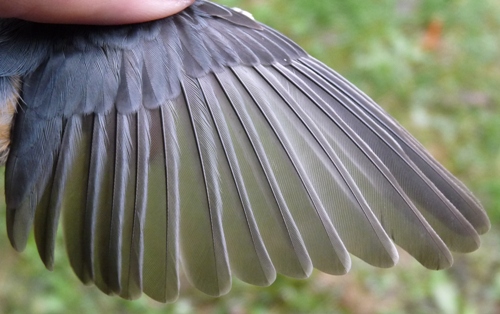
A typical AHY male wing, bluish-gray overall, with the broad bluish edging of the greater
coverts especially prominent, and narrower eding on most other feathers.
Photo by Marcel Gahbauer,
McGill Bird Observatory (QC), October 2010
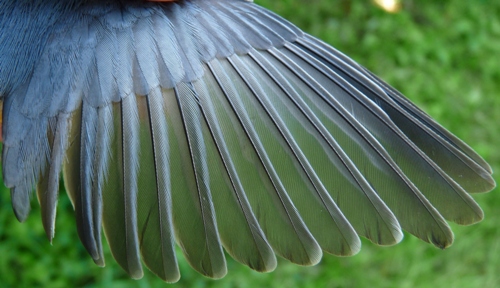
A more extensively blue wing, with more distinct edging on the primary coverts and
secondaries, and the greater coverts almost entirely bluish.
Photo by Marcel Gahbauer,
McGill Bird Observatory (QC), August 2009
As with other age/sex classes, the tail provides no useful clues.
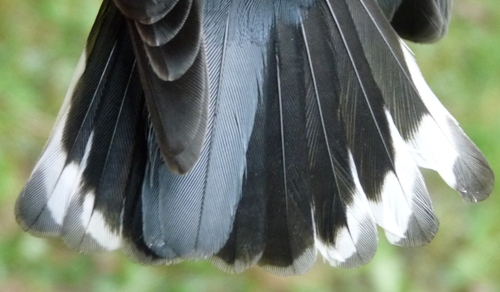
Photo by Marcel Gahbauer,
McGill Bird Observatory (QC), October 2010
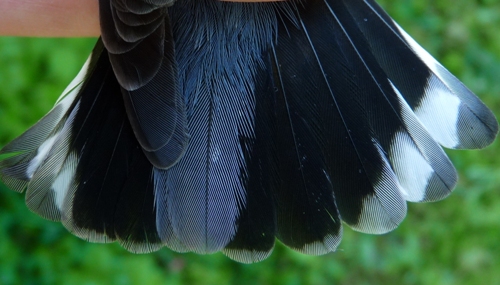
Note that the black pattern is more extensive on this tail and that the white does not extend
to r4, but this reflects individual variation rather than providing any clues ot age or sex.
Photo by Marcel Gahbauer,
McGill Bird Observatory (QC), August 2009
RETURN TO AGE/SEX
OVERVIEW
|
JUN - DEC: after-hatch-year
female |
Female Red-breasted Nuthatches have a distinctly duller cap than males; age must be determined either by checking skull pneumatization or considering the condition of the open wing.
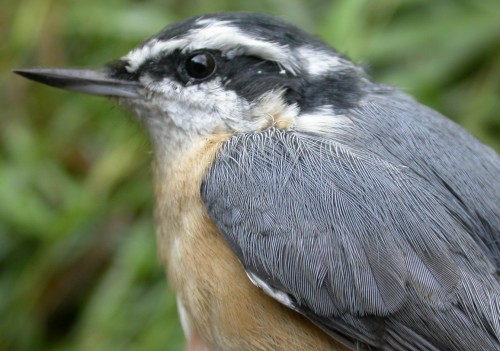
Photo by Marcel Gahbauer,
McGill Bird Observatory (QC), August 2005
Although somewhat duller than the wing of an AHY male, the AHY female wing still has some bluish tone throughout.
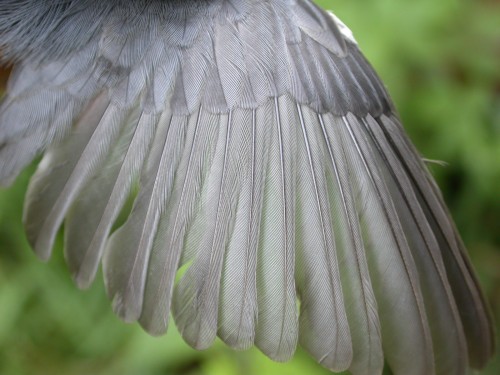
This wing is uniformly grayish, with some indistinct bluish edging to the coverts, similar
to the pattern seen on AHY males, but a bit duller.
Photo by Marcel Gahbauer,
McGill Bird Observatory (QC), August 2005
The tail does not provide any reliable clues for ageing or sexing.
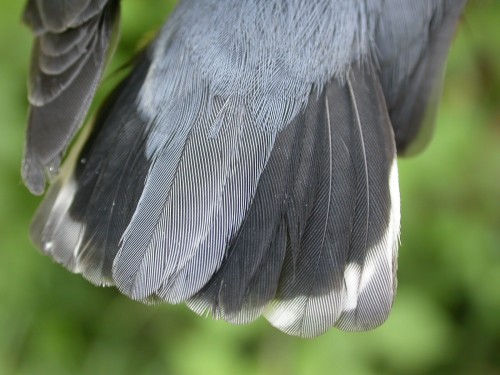
Photo by Marcel Gahbauer,
McGill Bird Observatory (QC), August 2005
RETURN TO AGE/SEX
OVERVIEW
|
JUN - DEC: hatch-year
male |
HY males generally appear very similar to AHY males, and can be distinguished only by confirming incomplete skull pneumatization or identifying juvenile feathers on the wing.
HY Red-breasted Nuthatches typically replace only lesser coverts and sometimes a few median coverts in their preformative molt, therefore the wing is almost entirely composed of juvenile feathers, generally lacking distinct blue edging. Note that in late summer and early fall when feathers are still relatively fresh, HY nuthatches may be more difficult to identify by wing due to the plumage being fresh, and skulling is a more reliable approach during that period.
The tail provides no useful clues regarding are or sex.
RETURN TO AGE/SEX
OVERVIEW
|
JUN - DEC: hatch-year
female |
HY females are generally similar in appearance to AHY females, and can be distinguished only by confirming incomplete skull pneumatization or identifying juvenile feathers on the wing.
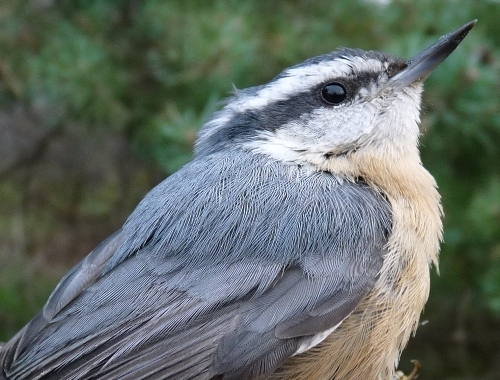
Photo by Marcel Gahbauer,
McGill Bird Observatory (QC), August 2009
Since HY Red-breasted Nuthatches typically replace only some lesser coverts and occasionally a few median coverts during their preformative molt, their wing comprises almost entirely juvenile feathers, which typically are duller and with less blue edging than basic feathers. However, in late summer and early fall when feathers are fresh, the difference can be more difficult to identify, and skulling is a more reliable approach.
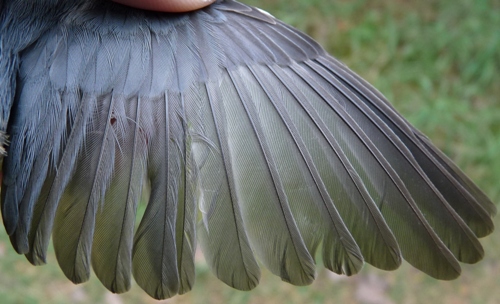
The bluish tone to the greater coverts and carpal covert are more typical of an AHY
Red-breasted Nuthatch, but this individual had a skull in the early stages of development,
highlighting that plumage cues must be interpreted with caution in this species.
Photo by Marcel Gahbauer,
McGill Bird Observatory (QC), August 2009
The tail provides no useful clues regarding age or sex.
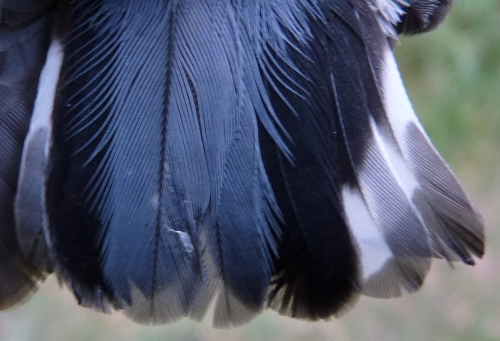
Photo by Marcel Gahbauer,
McGill Bird Observatory (QC), August 2009
RETURN TO AGE/SEX
OVERVIEW
|